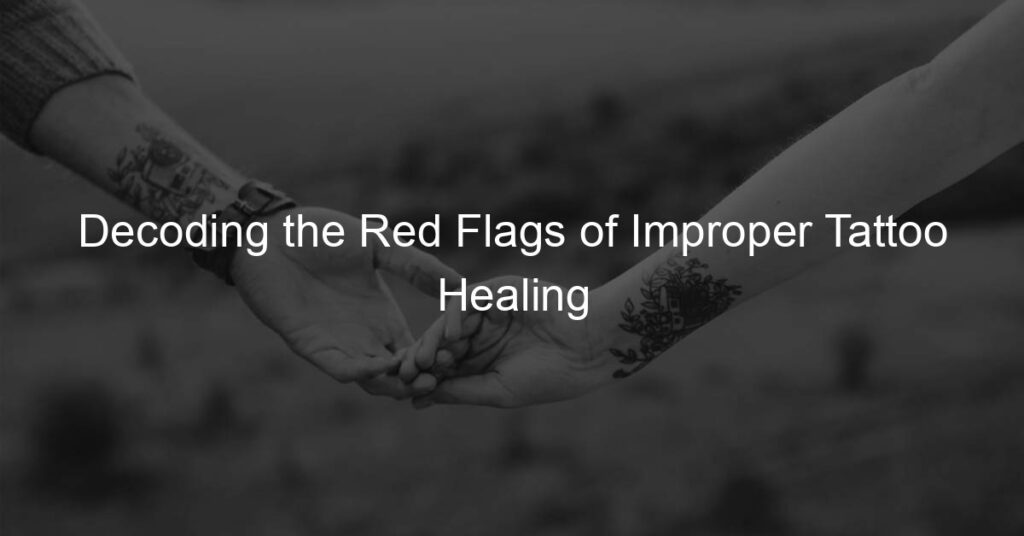Introduction to Tattoo Healing Process
Getting a tattoo is an exciting experience, but it’s only the first step in a journey. The most crucial part comes after the tattoo artist has finished their work – the healing process. This is where your body works to protect the beautiful new artwork on your skin. Let’s dive into the importance of proper tattoo healing and an overview of the tattoo healing stages.
-
- Understanding the Importance of Proper Tattoo Healing
When you get a tattoo, your skin is essentially experiencing a form of trauma. The tattoo needle punctures your skin hundreds of times per minute, inserting ink into the dermis – the second layer of skin. This process causes a wound, and your body immediately starts working to heal it. If this healing process isn’t handled correctly, it can lead to infection, scarring, and even damage to your new tattoo. That’s why understanding and following proper tattoo healing procedures is so important.
-
- Overview of the Tattoo Healing Stages
The tattoo healing process typically involves three main stages:
-
-
- Healing: This stage lasts for about a week. Your tattoo will be red, swollen, and sensitive. It may also weep a clear fluid, which is your body’s way of cleaning the wound.
- Peeling: After about a week, your tattoo will start to peel, much like a sunburn. It’s essential not to pick at or scratch your tattoo during this stage.
- Itching and final healing: For the next few weeks, your tattoo will itch as it heals. Again, it’s crucial not to scratch it. After about a month, your tattoo should be fully healed.
-
Remember, everyone’s body is different, so your healing process may not follow this exact timeline. The important thing is to listen to your body and take care of your tattoo as it heals.
Signs of Proper Tattoo Healing
When you get a new tattoo, it’s essential to know what a healthy healing process looks like. This way, you can ensure your tattoo heals correctly and maintains its vibrant colors and sharp lines. Let’s explore what to expect during the tattoo healing process and how to identify healthy tattoo healing stages.
-
What to Expect During the Tattoo Healing Process
After getting a tattoo, your skin will start a natural healing process. Here’s what you can expect:
- Day 1-3: Your tattoo will look bright and shiny. It may feel like a sunburn, and there might be some redness and swelling.
- Day 4-6: Your tattoo will start to peel, similar to a sunburn. This is normal, and you should not pick at it.
- Day 7-14: The peeling will continue, and the tattoo may start to itch. It’s important not to scratch it.
- Day 15-30: Your tattoo should be healed on the surface, but the deeper layers of skin are still healing. The tattoo may look a bit cloudy, but this will clear up as the deeper skin heals.
-
How to Identify Healthy Tattoo Healing Stages
Knowing the signs of healthy tattoo healing can help you ensure your tattoo is healing properly. Here are some signs to look for:
- Minimal Redness and Swelling: Some redness and swelling are normal, but it should reduce after a few days.
- Peeling and Itching: Your tattoo will start to peel and itch after a few days. This is a sign that your skin is healing.
- Light Scabbing: Light scabbing is normal, but heavy scabbing could be a sign of a problem. If you notice heavy scabbing, contact your tattoo artist or a healthcare professional.
- Clearing of Cloudiness: After a few weeks, the cloudiness should clear up, and your tattoo should look bright and clear.
Remember, everyone’s body heals at a different rate, so your healing process might not match this timeline exactly. The most important thing is to keep your tattoo clean and moisturized, and to avoid picking at it or scratching it. If you notice any signs of infection, such as increased redness, swelling, or pus, contact a healthcare professional immediately.
Red Flags: Incorrect Tattoo Healing Symptoms
Getting a tattoo is an exciting experience, but it’s essential to keep an eye on the healing process. Sometimes, things might not go as planned. Here are some red flags you should watch out for.
Signs of Tattoo Infection
An infected tattoo can cause serious health problems if not treated promptly. Here are some signs that your tattoo might be infected:
-
- Unusual swelling or redness: While some swelling and redness are normal after getting a tattoo, if it persists for more than a few days or gets worse, it could be a sign of infection.
Usually, a new tattoo will have some redness and swelling. But, if these symptoms don’t go away after a few days or they get worse, it might mean there’s an infection. This is a red flag that you shouldn’t ignore.
-
- Persistent pain or discomfort: It’s normal for a new tattoo to be a bit sore, but if the pain doesn’t subside after a few days or becomes more intense, it could indicate an infection.
Your new tattoo might feel a bit sore at first, which is completely normal. But, if the pain keeps going for more than a few days or it gets worse, this could be a sign of an infection. Don’t ignore this symptom.
-
- Discharge or foul smell: If your tattoo starts to discharge pus or has a bad smell, it’s a clear sign of infection. In such cases, you should seek medical attention immediately.
If your tattoo starts to leak pus or it smells bad, this is a clear sign that something is wrong. This could mean your tattoo is infected. If this happens, you should go see a doctor right away.
Remember, it’s always better to be safe than sorry when it comes to your health. If you notice any of these symptoms, don’t hesitate to seek medical attention. It’s better to catch an infection early than to let it get worse.
Tattoo Healing Problems
While tattoos are a beautiful form of self-expression, they can sometimes lead to certain healing problems. It’s crucial to recognize these issues early to prevent any long-term damage to your skin or the tattoo itself. Let’s discuss some common tattoo healing problems:
-
- Excessive Scabbing or Peeling
Scabbing and peeling are normal parts of the tattoo healing process. However, excessive scabbing or peeling may indicate a problem. This could be due to a variety of reasons, such as poor aftercare, an overly aggressive tattooing technique, or an infection. If you notice large, thick scabs or if your tattoo starts to peel excessively, it’s best to consult with a professional.
-
- Blurred Lines and Color Fading
Blurred lines and color fading can occur if the tattoo doesn’t heal properly. This can happen if the tattooed skin is excessively exposed to the sun, or if the aftercare instructions aren’t followed correctly. It’s important to keep the tattooed area moisturized and protected from the sun to ensure the lines stay sharp and the colors vibrant.
-
- Allergic Reactions to Tattoo Ink
Allergic reactions to tattoo ink, while rare, can occur. Symptoms can include itching, redness, swelling, and even blisters. If you experience any of these symptoms, it’s important to seek medical attention immediately. To prevent this, consider doing a patch test with the tattoo ink before getting the actual tattoo.
In conclusion, while tattoos are generally safe, they can sometimes lead to healing problems. By being aware of these issues and taking the necessary precautions, you can ensure your tattoo heals properly and looks its best for years to come.
Tattoo Aftercare: How to Heal a Tattoo
After getting a tattoo, the journey to a vibrant and healthy tattoo is not over. Proper aftercare is crucial to ensure the longevity of your tattoo and to avoid any complications. Here are some tips to help you through the healing process.
Tattoo Healing Tips
These are some of the most effective ways to ensure your tattoo heals properly:
- Proper cleaning and moisturizing: Cleaning your tattoo is the first step in the healing process. Use a mild, fragrance-free soap and warm water to gently clean the tattooed area. Pat it dry with a clean towel and apply a thin layer of fragrance-free moisturizer. This should be done twice a day.
- Avoiding sun exposure and swimming: Sunlight and water can fade your tattoo and slow down the healing process. It’s best to avoid direct sunlight and refrain from swimming until your tattoo is fully healed.
- Wearing loose, breathable clothing: Tight clothing can rub against your tattoo and cause irritation. Opt for loose, breathable clothing that won’t stick to your tattoo.
Remember, everyone’s body heals at different rates. It’s important to listen to your body and give it the time it needs to heal. If you follow these tips, you’ll be well on your way to a beautifully healed tattoo.
Dealing with Tattoo Healing Issues
When you get a new tattoo, it’s important to know how to handle any healing issues that may arise. This includes knowing when to seek medical attention and how to deal with minor problems at home. Let’s explore these two key areas.
-
- When to Seek Medical Attention
If your tattoo shows signs of infection, it’s crucial to seek medical attention immediately. These signs may include:
-
-
- Severe redness or swelling that doesn’t improve after a few days
- Pus or discharge coming from the tattoo
- Increasing pain or discomfort
- Fever or chills
-
Remember, it’s always better to be safe than sorry. If you’re unsure whether your symptoms are normal, it’s best to consult a healthcare professional.
-
- How to Handle Minor Tattoo Healing Problems
Minor tattoo healing problems can often be managed at home. Here are a few tips:
-
-
- Itching: This is a common part of the healing process. Resist the urge to scratch and instead apply a gentle, fragrance-free moisturizer.
- Mild redness or swelling: Apply a cold compress to the area for 15 minutes at a time. If it doesn’t improve after a few days, seek medical advice.
- Peeling or flaking: This is a normal part of the healing process. Do not pick at the skin. Continue to moisturize and let it heal naturally.
-
Always remember, proper aftercare is key to a well-healed tattoo. If you’re ever in doubt, don’t hesitate to reach out to a healthcare professional.
In conclusion, dealing with tattoo healing issues can be straightforward when you know what to look for and how to respond. Always prioritize your health and don’t hesitate to seek medical attention when necessary.
Case Studies: Tattoo Healing Gone Wrong
Getting a tattoo is an exciting experience, but the healing process is crucial to ensure the tattoo looks good and stays healthy. Unfortunately, not all tattoo healing processes go as planned. Let’s look at some real-life examples of tattoo healing gone wrong and the lessons we can learn from them.
- Real-life examples of improper tattoo healing
One example involves a woman named Sarah. Sarah got a large, colorful tattoo on her back. She was given aftercare instructions by her tattoo artist, but she didn’t follow them closely. She often forgot to clean the tattoo and apply the recommended ointment. After a week, her tattoo became red, swollen, and painful. It was infected. Sarah had to visit a doctor for treatment, and her tattoo’s appearance was permanently damaged.
Another case is of a man named Mike. Mike got a small tattoo on his arm. He took care of it properly, but he made one crucial mistake – he exposed his fresh tattoo to direct sunlight for extended periods. This caused his tattoo to fade quickly and even peel in some areas.
- Lessons learned from tattoo healing issues
From Sarah’s case, we learn the importance of following aftercare instructions. Cleaning the tattoo and applying ointment regularly can prevent infections and ensure the tattoo heals properly. Ignoring these steps can lead to painful complications and damage the tattoo’s appearance.
Mike’s case teaches us about the dangers of sun exposure. Fresh tattoos are sensitive and should be protected from the sun to prevent fading and peeling. Even after the tattoo has healed, it’s a good idea to apply sunscreen before spending time outdoors to keep the tattoo vibrant.
These cases highlight the importance of proper tattoo aftercare. By following the recommended steps and avoiding common mistakes, you can ensure your tattoo heals correctly and looks its best for years to come.
Conclusion: Ensuring Proper Tattoo Healing
As we reach the end of our comprehensive guide on tattoo healing, it’s important to remember that taking care of your new tattoo is just as crucial as the process of getting it. Let’s recap the key points and understand why following aftercare instructions is paramount.
-
- Key takeaways for successful tattoo healing
Firstly, remember that every tattoo goes through a healing process that typically lasts between 2 to 4 weeks. During this time, it’s normal to experience some redness, swelling, and scabbing. However, if these symptoms persist or worsen, it’s a sign that your tattoo may not be healing properly.
Secondly, maintaining cleanliness is key. Always wash your hands before touching your tattoo and clean it gently with a mild, fragrance-free soap. Avoid soaking your tattoo in water and keep it protected from the sun.
Lastly, moisturize your tattoo regularly with a tattoo-specific lotion or ointment. This not only helps to keep your skin hydrated but also aids in the healing process.
-
- The importance of following tattoo aftercare instructions
Following the aftercare instructions provided by your tattoo artist is vital for the longevity and vibrancy of your tattoo. Ignoring these guidelines can lead to complications such as infections, color fading, and even tattoo healing gone wrong.
Remember, your tattoo is a personal investment and a form of self-expression. By taking the necessary steps to ensure its proper healing, you’re not only preserving its beauty but also protecting your health.
In conclusion, tattoo healing is a process that requires patience, care, and attention. By understanding the signs of proper healing and being aware of potential red flags, you can ensure that your tattoo heals successfully and continues to be a source of pride and joy for years to come.






